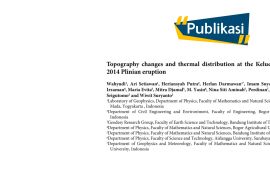Abstract
Rebon Seminar : Potential Application of Entropy Permutation In Monitoring Near-Real Time Of Gunungapi Seismic Activity in Indonesia
Speaker : Dr. Afif Rakhman, S.Si., M.T.
Rebon Seminar : Research Contribution of The Department of Physics during the Covid-19 Pandemic
Abstract
It has been successfully synthesized silver nanoparticles by chemical reduction methods. Silver nitrate (AgNO3) is used as a metal precursor and trisodium citrate as a reducing agent with varying concentrations of the stabilizer PVA. The UV-Vis spectrometer shows that increasing the mass concentration of the stabilizer can sharpen the surface plasmon maximum absorption band and there is a shift in the maximum absorption band towards a larger wavelength. This shift occurred from a wavelength of 428.79 nm at a PVA concentration of 0.85 ppm shifted to a wavelength of 429.01 nm, 430.93 nm and 434.13 nm for each PVA concentration of 1.70 ppm, 2.55 ppm and 4.25 ppm. The observation results of the SPR phenomenon showed a shift in the SPR angle when a thin layer of silver as the active ingredient of the sensor was coated with silver nanoparticles. This addition also sharpens the reflectance value. The SPR angle shift and the increase in reflectance value are caused by changes in the surface plasmon wave constant, which becomes a reference that the SPR phenomenon by modifying the sensing surface using an additional layer of silver nanoparticles can increase its sensitivity.
Author : L Mahmudin, D Darwis, E Suharyadi, ABS Utomo, K Abraha





